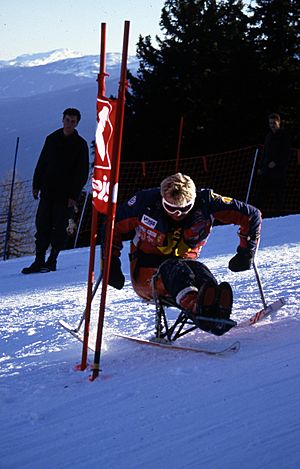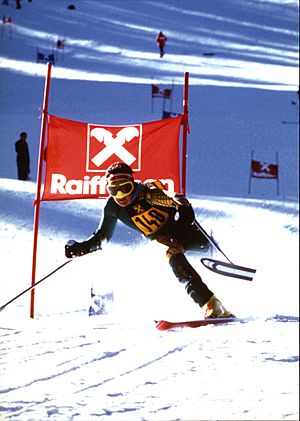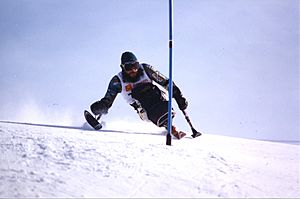Para-alpine skiing facts for kids
Alpine skiing is a fun winter sport where people ski down snowy mountains. Para-alpine skiing is a special version of this sport for people with disabilities. It started in Germany and Austria during and after World War II. The sport is managed by the International Paralympic Committee Sports Committee. Skiers use special equipment like ski poles with small skis on the end (called outrigger skis), or a special chair on a ski (called sit-skis or mono-skis). The main types of Para-alpine skiing races are Downhill, Super-G, Giant Slalom, Slalom, Super Combined, and Snowboard.
To make sure races are fair, Para-alpine skiing uses a special system called Para-alpine skiing classification. This system groups skiers based on their physical or visual abilities. There are three main groups: standing skiers, visually impaired skiers, and sitting skiers. A "factoring system" also helps make sure that skiers within these groups can compete fairly against each other, even if their disabilities are a little different.
Para-alpine skiing was one of the first sports at the Winter Paralympics in 1976, with Slalom and Giant Slalom races. Over time, more types of alpine skiing were added to the Paralympic Games. For example, at the 2010 Winter Paralympics, races like Downhill, Super-Combined, Super-G, Slalom, and Giant Slalom were held at Whistler Creekside.
Contents
History of Para-Alpine Skiing
Skiing for people with disabilities began around World War II. Many soldiers were hurt during the war and needed new ways to enjoy sports. In Germany, Franz Wendel, who had lost a leg, used crutches to help him ski. In Austria, Sepp "Peppi" Zwicknagel, a soldier who lost a leg, taught himself to ski. He later became a ski instructor and helped create a special group for disabled skiers in the Austrian Ski Association. By 1947, ski races for people with disabilities were already happening in Austria.
Later, Ludwig Guttman also helped create ski events for people with disabilities. In the United States, Gretchen Fraser started teaching skiing to soldiers who had lost limbs in army hospitals. By the 1960s, many ski groups for people with disabilities were forming. At first, only people with amputations could join. But in 1969, a blind ski instructor named Jean Eymore started a skiing program in Aspen, Colorado, for skiers who couldn't see. The first big international competition, the World Disabled Alpine Championships, took place in France in 1974.
Para-Alpine Skiing at the Paralympics
Standing alpine skiing was one of the first sports at the very first Winter Paralympics in 1976. Back then, only Slalom and Giant Slalom races were held. At the 1984 Winter Paralympics, the Downhill race was added. Sit-skiing was also shown as a special demonstration sport that year.
At the 1992 Winter Paralympics in Albertville, Canada, Downhill, Giant Slalom, and Slalom events were all part of the Paralympic program. In 1994, the Super Giant Slalom (Super-G) race was added. A big change happened in 1998: for the first time, sit-skiers and blind skiers could win medals. Before 1998, only standing skiers could win medals at the Winter Paralympics.
The 2010 Winter Paralympics held Para-alpine skiing races at Whistler Creekside. These races included Downhill, Super-Combined, Super-G, Slalom, and Giant Slalom. The Super-Combined event was new to the Paralympic Games in 2010.
Rules and Events
Para-alpine ski events happen all over the world. These include the Winter Paralympics, World Championships, World Cups, and other national competitions. Skiers from many different countries (around 39!) take part in these races.
The sport is governed by the International Paralympic Committee Sports Committee. They have special rules for Para-alpine skiing, which are based on the rules of the International Ski Federation (FIS). The FIS sets the general rules for alpine skiing, and the IPC makes changes to fit Para-alpine skiing. This way, the rules work together smoothly. Sometimes, special rules are made for big events like the Paralympic Games.
Equipment for Para-Alpine Skiing

Para-alpine skiers use special equipment to help them compete. This includes outrigger skis, sit-skis, and mono-skis. Depending on whether a skier sits, stands, or cannot see, they might use other things like guide skiers, short ski poles, orthopedic aids, or prostheses.
For skiers who have trouble seeing, guides are very important. They ski ahead and use a radio or their voice to tell the visually impaired skier where to go. Guides must also follow the rules, including anti-doping rules.
The rules for equipment are set by both the FIS and the IPC. For example, skis used in competition must be a certain length: at least 165 cm for men and 155 cm for women.
Sit-skis are used by skiers who use wheelchairs or have paraplegia. The first sit-ski was made in 1967 in Germany. Early sit-skis were heavy and hard to use on steep slopes. But they kept getting better! Modern sit-skis are made from light materials like fiberglass and polyester. They are much lighter, allowing skiers to go on steeper slopes and even ski over bumps (moguls). Today's sit-skis also include seat belts for safety.
Some standing skiers use outrigger skis. These are like ski poles but have small skis on the end. They help skiers keep their balance when skiing down a mountain and can also help them move short distances uphill, like getting onto a ski lift.
Skiers also wear special boots, helmets, ski suits, and goggles. All helmets must be hard-shell helmets for safety.
Types of Para-Alpine Skiing Races
Para-alpine skiing includes several exciting race types: Downhill, Super-G, Giant Slalom, Slalom, Super Combined, and Snowboard. The rules for these races are based on regular alpine skiing rules, but they are adjusted for skiers with disabilities. Skiers can reach speeds of up to 100 km per hour!
Downhill
This is a super fast, timed ski race. Skiers go quickly down a steep slope that can drop between 450 and 800 meters. The goal is to finish in one run, and the skier with the fastest time wins. Skiers must pass between gates, but Downhill has the fewest gates of all Para-alpine races. If a skier misses a gate, they are out of the race. Skiers often reach speeds of 100 km per hour in this event. Before the race, skiers must do a practice run and always wear a helmet.
Super-G
The Super-G (Super Giant Slalom) was created in the 1980s. It's a very fast race, but with fewer turns than Slalom. Skiers go down a mountain that drops between 400 and 600 meters. It's a mid-length race, longer than Giant Slalom and Slalom, but shorter than Downhill. Skiers race quickly between red and blue gates that are 25 meters apart. Men need to pass through about 35 gates, and women through 30 gates.
Giant Slalom
This race requires very precise turning. Skiers go down a mountain that drops between 300 and 400 meters. It's straighter and shorter than Downhill, but longer and has fewer turns than Slalom. Skiers get two runs down the mountain. Their final position is based on their total time from both runs. After the first run, the slowest 20% of skiers might be removed from the competition. The starting order for the second run is interesting: the slowest of the top 15 skiers goes first, and the fastest skier from the first run goes 15th. Skiers use straight ski poles in Giant Slalom. This race is part of the Paralympic Games.
Slalom
The name "Slalom" comes from a Norwegian word meaning "sloping footway." This is the most challenging ski race, with a drop of only 140 to 220 meters on a specially iced mountain. It's the shortest Para-alpine race and uses two different courses. Skiers go down each course once, and their final score is based on their total time from both runs. There are many gates in this race (55-75 for men, 40-60 for women), and skiers must pass through every single one. If they miss a gate, they are out. Similar to Giant Slalom, the slowest 20% of finishers might be removed after the first run. Skiers use straight ski poles and often wear extra protective equipment because of the tight turns. Slalom is also a race on the current Paralympic schedule.
Super Combined
The Super Combined race mixes two different types of skiing: Slalom and either Super-G or Downhill. In this event, skiers complete one Downhill run and two Slalom runs. The times from all three runs are added together, and the skier with the fastest total time wins.
Snowboard
Snowboard races involve drops between 100 and 240 meters over a distance of 400 to 900 meters. Skiers go through alternating ski gates. This sport is currently only open to standing racers in Para-alpine skiing.
Para-Alpine Skiing Classification
 In Spanish: Esquí alpino adaptado para niños Para-alpine skiing classification is a system that makes sure competitions are fair for skiers with different physical and visual abilities. Skiers are grouped into three main categories: standing, visually impaired, and sitting.
In Spanish: Esquí alpino adaptado para niños Para-alpine skiing classification is a system that makes sure competitions are fair for skiers with different physical and visual abilities. Skiers are grouped into three main categories: standing, visually impaired, and sitting.
The International Paralympic Committee Alpine Skiing (IPCAS) manages this classification. Skiers are classified based on their medical condition and how their body works when they ski. Visually impaired skiers are classified based on how well they can see. Before IPCAS took over, different sports groups handled classification.
The first classification systems were created in Scandinavia for skiers with amputations. Over time, the systems improved to focus more on how a skier's body can function during the sport, rather than just their medical condition. By the 1980s, there were ten different classes. Since then, efforts have been made to simplify the system by having fewer classes, which also means fewer medals are awarded.
| Type | What it means | Equipment |
|---|---|---|
| LW 1 | Both legs are missing above the knee, or similar severe disability | Two skis, two outrigger skis |
| LW 2 | One leg is missing above the knee | Two skis, two outrigger skis |
| LW 3 | Both legs are missing below the knee, or similar disability | Two skis, two ski poles |
| LW 4 | One leg is missing below the knee | Two skis, two ski poles |
| LW5/7-1 | Both arms are missing above the elbow | Two skis, no ski poles |
| LW 5/7-2 | Both arms are missing, one above and one below the elbow | Two skis, no ski poles |
| LW 5/7-3 | Both arms are missing below the elbow | Two skis, no ski poles |
| LW6/8.1 | One arm is missing above the elbow | Two skis, one ski pole |
| LW 6/8.2 | One arm is missing below the elbow | Two skis, one ski pole |
| LW9.1 | Missing or similar problem with one arm and one leg (above the knee) | Skier can choose equipment |
| LW9.2 | Missing or similar problem with one arm and one leg (below the knee) | Skier can choose equipment |
| Type | What it means |
|---|---|
| LW10.1 | Legs and lower body are paralyzed, with no upper body or sitting balance |
| LW 10.2 | Legs and lower body are paralyzed, with some upper body but no sitting balance |
| LW11 | Legs and lower body are paralyzed, with good sitting balance |
| LW12.1 | Legs and lower body are paralyzed, with some leg movement and good sitting balance |
| LW 12.2 | Both legs are missing above the knees |
| Type | What it means |
|---|---|
| B1 | Completely unable to see |
| B2 | Very limited vision (less than 2/60) |
| B3 | Limited vision (2/60 to 6/60) |
Factor System for Fair Play
A special "factoring system" is used in Para-alpine skiing for the three main groups: sitting, standing, and visually impaired. Each group races only against others in their own group. This means a skier can win in their specific group (e.g., "top three for sitting skiers").
Even within these groups, skiers have different levels of ability. The factoring system helps make the competition fair. It works by giving each class a special number. After a skier finishes, their actual race time is multiplied by this number. The new, adjusted time is what's used to decide the winner. This means the fastest skier down the hill might not always be the winner if their "factored time" is slower.
This factoring system is used in many big competitions, including the Alpine Cup, North American Races, European Cup, World Cup races, World Championships, and the Winter Paralympics.
Images for kids






